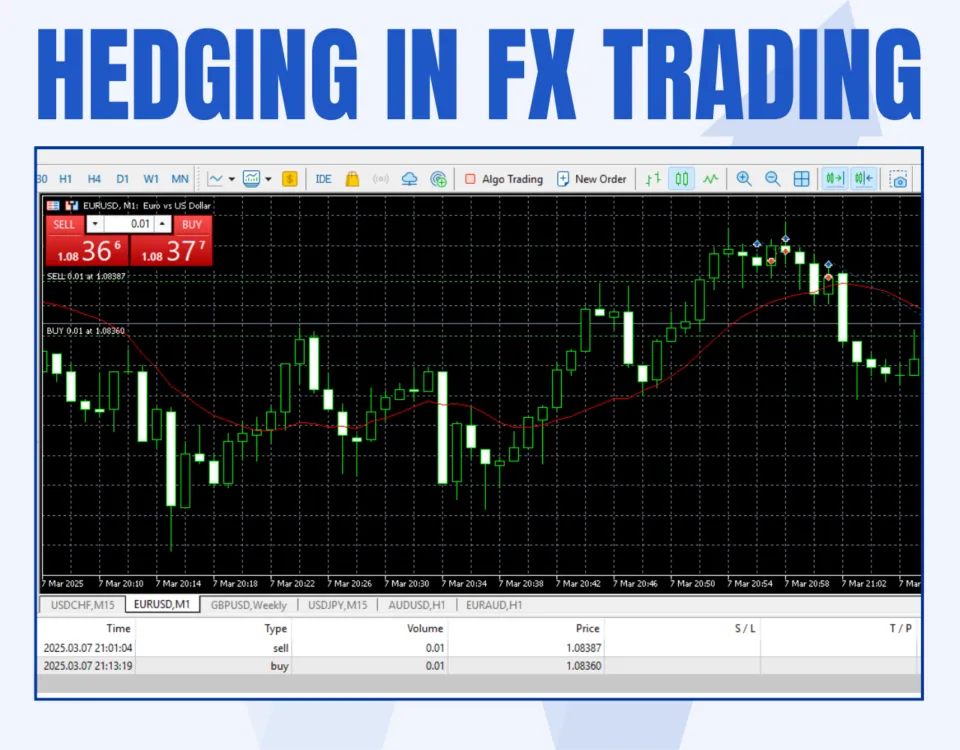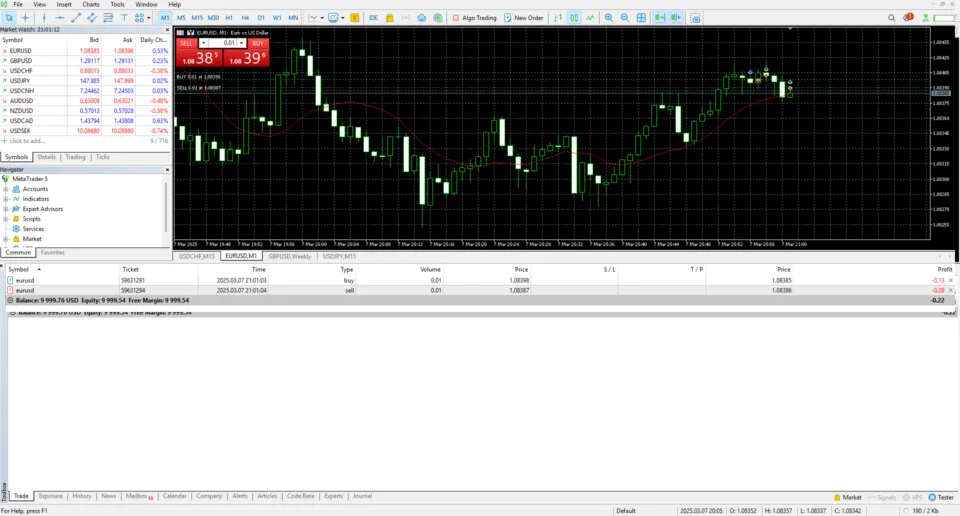Forex hedging refers to a risk management strategy employed by traders (and businesses) to protect against adverse price movements in the foreign exchange market. The forex market is highly volatile, with exchange rates fluctuating due to economic, political, and market-related factors, and hedging allows you to minimize potential losses by taking offsetting positions in the market.
By understanding and implementing effective hedging strategies, you can stabilize your cash flow, protect your profit margins, and better maintain financial predictability when trading forex.

Key Facts about Hedging in Forex Trading:
- Hedging’s purpose: Forex hedging is mainly a way to reduce financial risks that stem from currency fluctuations.
- Tools: Hedging strategies often involve financial instruments such as options, futures, and contracts for differences (CFDs).
- Dual positioning: Traders typically open opposing positions in correlated currency pairs when hedging, or use derivatives to offset their risks.
- Not for profit: Hedging is not aimed at generating a profit, but rather aimed at minimizing losses.
- Complexity: Successful hedging requires a fluid understanding of market dynamics and products, as well as great execution timing.
(Never Trade In Uncertainty Again – Join The WR Trading Mentorship)
How to Hedge in Forex Trading?
You can do this using several techniques, including spot market trades, employing derivatives, as well as the strategic use of correlated currency pairs.
The process generally includes identifying your risk exposure, selecting an appropriate hedging strategy, and monitoring market conditions to adjust the hedge as you see necessary. Hedging in forex trading involves taking a position in the forex market that offsets the risk of an existing position, or a position you anticipate taking.
Here are the steps common to almost any effective hedging strategy:
- Identify your exposure. Determine the currencies and positions at risk (whether this is due to open trades or future obligations).
- Select your hedging strategy. Choose a method suited to the level of risk and market conditions – you might look at direct hedging, options, or futures.
- Execute the hedge. Use your forex trading platform or financial products to implement the strategy.
- Monitor and adjust. Regularly assess the effectiveness of the hedge you’ve employed, and make adjustments as needed.
In the context of forex trading, hedging is not only a trader’s tool, but is also often used by corporations involved in international trade or investors with exposure to foreign currencies.
For example, a US company expecting to receive payments in euros may hedge its exposure to potential euro depreciation by entering into contracts that protect its value. Similarly, you can use hedging techniques when trading forex to limit your downside risk during market turbulence.
Example of a Forex Hedge
Suppose a U.S.-based company expects to receive €1 million in six months for an export order just shipped. The company is a high-volume-low-margin business, so even a slight depreciation in the euro will impact its foreign revenue, and can have a big impact on their annual profits (if the euro depreciates against the dollar, the company’s dollar revenue will decrease).
To hedge this risk, the company could:
- Enter into a forward contract. The company can agree to sell €1 million at a predetermined rate in six months time, locking in the exchange rate.
- Use an option. The company might also look at purchasing a put option on the euro, giving it the right (but not the obligation) to sell euros at a specific price.
- Offset the risk in the spot market. They could open a short position in EUR/USD in the spot market, to balance the potential loss from euro depreciation.

By hedging, the company ensures that its cash flows remain stable regardless of market movements, and that it doesn’t anticipate profits that evaporate when payment finally lands.
(Never Trade In Uncertainty Again – Join The WR Trading Mentorship)
Reasons to Start Forex Hedging
Forex hedging offers several benefits for both individual traders and businesses, and below are the key reasons to consider implementing hedging in your Forex Trading:
- Protection against Volatility: Currency markets are influenced by a multitude of factors, including geopolitical events, interest rate decisions, and economic data releases. Hedging helps protect you against sharp and unexpected price swings that could lead to significant financial losses in your trading.
- Stabilizing cash flows: For businesses, especially those involved in international trade, forex hedging ensures predictable cash flows. For companies, this is crucial for budgeting, financial planning, and maintaining profit margins, and the same applies to you as a forex trader-anything that can maintain your consistent profitability is worthwhile.
- Mitigating Exchange Rate risk: Traders and corporations exposed to foreign currency transactions face the risk of unfavorable exchange rate movements over which they have no control. Hedging minimizes this risk by locking in favorable rates, or at least offsetting potential losses.
- Managing Leverage risk: Forex trading often involves leverage, which can amplify both your profits and your losses. Hedging gives you a safety net around your leveraged positions, reducing the likelihood of substantial losses.
Forex Hedging Strategies explained
There are several hedging strategies that traders and businesses can use to mitigate forex risks – here are the most common types:
1. Direct Hedging
Direct hedging means opening a position that directly offsets an existing trade.
For example, if you have a long position in EUR/USD, you might open a short position of the same size in the same currency pair. This will ensure that losses in one of your positions will be countered by gains in the other.

2. Hedging with Options
Options provide you the right, but not the obligation, to buy or sell a currency by a certain date and at a predetermined price. This gives tremendous flexibility and allows you to hedge against unfavorable movements, while still benefiting from favorable changes.
3. Hedging with Futures
Futures contracts are standardized agreements to buy or sell a currency at a set price and date and, unlike with options, there is a contractual obligation to effect the transaction when due.
For obvious reasons, these contracts are commonly used by businesses to lock in exchange rates for future transactions.
4. Cross-hedging
Cross-hedging involves hedging a currency by taking a position in a different but closely correlated currency pair. For example, to hedge GBP/USD exposure, you might use EUR/USD if the euro and pound tend to move in similar directions.
5. Multiple Currency Hedging
For traders (or businesses) with exposure to multiple currencies, a portfolio hedging approach can be employed.
This involves creating a basket of hedges tailored to offset risks across several currency pairs, something that demands detailed analysis, but can pay dividends in substantially offsetting your risks.
(Never Trade In Uncertainty Again – Join The WR Trading Mentorship)
Which Financial Products can be used for Forex Hedging?
You can hedge in forex trading using options, futures, CFDs, forward contracts, and even currency swaps and ETFs. Each of these products serves a distinct purpose, depending on your objectives, exposure level, and your market outlook. Below are all of the most common financial products used for forex hedging, along with an example of their application:
1. Options
Options are in fact derivatives that give you, the buyer, the right without obligation to buy (call) or sell (put) an underlying asset at a predetermined price and within a specified timeframe. Options allow you to hedge risk while retaining your flexibility-they can be a safeguard you hopefully won’t need to deploy.
A call option, for example, will protect you against upward price movement, while a put option protects against downward price movement.
Options give you a unique flexibility, as you are under no obligation to exercise your rights as determined by the option – it’s optional.
- Options provide flexibility and limited downside risk.
- They involve paying a premium for the option.
- And they’re useful when there is uncertainty about market direction and you want to mitigate your risk.
Say a Japanese company, for example, plans to pay USD 1 million for raw materials in three months. To protect against a potential appreciation of the U.S. dollar, the company purchases a call option with a strike price of 135 JPY/USD. If the USD strengthens to 140 JPY/USD, the company exercises the option, locking in the 135 JPY/USD rate, thus avoiding the higher cost.
2. Futures Contracts
Futures contracts are traded on regulated exchanges, and are standardized agreements to buy or sell a currency at a set price and fixed date in the future. They lock in exchange rates for a specific date in the future, making them especially suitable for businesses with predictable cash flow requirements.
While it’s fairly standard practice for uncountable companies the world over, hedging with futures still carries some basic risk (your hedge often doesn’t move in exact inverse correlation to your asset).
When using futures contracts to hedge, there is an imperfect relationship between your two positions, although the strategy is largely successful.
- They are traded on exchanges like the Chicago Mercantile Exchange (CME).
- Futures contracts are standardized – they have fixed sizes and expiration dates.
- They require margin deposits and daily mark-to-market adjustments.
As an example, imagine a Canadian exporter expects to receive USD 500,000 in four months. To hedge against the risk of the U.S. dollar depreciating against the Canadian dollar, they sell a USD futures contract on the CME. If the U.S. dollar weakens, the gain from the futures contract offsets the loss from the unfavorable exchange rate when converting their USD earnings.
3. CFDs (Contracts for Difference)
CFDs are derivative instruments that let you speculate on price movements without actually owning the underlying asset. While CFDs are considered high-risk as a general rule of thumb, and generally used for speculation, they can be used effectively for especially short-term hedging.
- With CFDs, you have no ownership of the underlying currency.
- Your hedging will involve opening a position opposite to an existing one in the forex market.
- Traders can hedge with CFDs through online brokers.

Let’s say you’re holding a long position in EUR/USD, but anticipate short-term volatility. You’ll open a short CFD position on EUR/USD for the same amount and, if the euro weakens, the loss from your long position is offset by the gain from your short CFD position.
4. Forward Contracts
Forward contracts are over-the-counter (OTC) agreements between two parties to buy or sell a specified amount of currency at a preset exchange rate, on a future date.
Unlike futures contracts that are standardized, forward contracts are the OTC version – completely customizable – but come with higher counter-party risk.
- They have customizable terms, including the amount, the currency pair, and settlement date.
- Forward contracts are used for hedging specific currency exposures in the future.
- They are not traded on exchanges, making them less liquid but highly flexible.
In a classic example of forward contract hedging, a US-based importer expects to pay €1 million to a European supplier in six months. Worried that the euro might strengthen against the U.S. dollar, they enter into a forward contract with a bank to buy €1 million at an agreed rate of 1.10 USD/EUR. Regardless of how the EUR/USD rate moves, the importer is protected from adverse currency fluctuations.
5. Currency Swaps
Currency swaps are agreements between two parties to exchange cash flows in different currencies, typically involving the exchange of principal and interest payments. Currency swaps will exchange principal and interest payments in one currency for another, and they’re often used by corporations for long-term hedging.
- Currency swaps are commonly used by corporations and financial institutions for long-term hedging.
- They typically involve swapping a fixed interest rate in one currency for a floating rate in another currency.
- This helps manage both currency and interest rate risk.

Say an Australian company issues a bond in US dollars but earns revenue in Australian dollars. To hedge against currency risk, the company enters into a currency swap with a bank to exchange USD interest payments for AUD payments. This ensures that the company’s cash flows are aligned with its operating currency.
6. Exchange-Traded Funds (ETFs)
ETFs are investment funds traded on stock exchanges that hold a diversified portfolio of assets, such as stocks, bonds, or currencies, and are designed to track the performance of a specific index or sector.
Forex-related ETFs provide exposure to currency movements and can be used as a hedging tool for portfolio diversification.
- ETFs provide indirect exposure to currency pairs.
- They are useful for passive hedging strategies.
They represent ease of access. ETFs can be traded like stocks through brokerage accounts, making them accessible even to small-scale investors.
- Currency ETFs often include a basket of currencies, providing broader hedging options.
- Compared to more complex derivatives like forwards or options, ETFs are typically more cost-effective, as they involve lower fees and less expertise.
As an example, let’s say an investor holding a portfolio of European stocks is concerned about the euro weakening against the US dollar. They purchase a currency-hedged European equity ETF, which mitigates the impact of currency fluctuations on their portfolio returns.
As another example, suppose you as a trader earn income in euros, but have expenses in US dollars. To hedge against a potential depreciation of the euro, you can buy a euro-tracking ETF like Invesco Currency Shares Euro Trust – if the euro depreciates, the gains from the ETF offset the losses in your real income.
| Instrument | Use Case | Key advantage | Key limitation |
|---|---|---|---|
| Options | Protect against adverse movements while retaining upside potential | Limited downside risk | High premiums and complexity |
| Futures contracts | Standardized and exchange-traded for broader currency risk | Transparent pricing and liquidity | Less flexibility due to standardization |
| CFDs | Short-term speculative hedging or offsetting existing forex positions | Flexibility and ease of access | High leverage increases risk |
| Forward contracts | Hedging specific future payments or receipts | Fully customizable | Illiquid and counterparty risk |
| Currency swaps | Managing long-term exposures, often for large institutional needs | Aligns cash flows with operating currency | Complex and typically limited to large corporations |
| ETFs | Passive hedging of portfolio exposure | Convenient for retail investors | Limited scope for precise currency risk management |
(Never Trade In Uncertainty Again – Join The WR Trading Mentorship)
How to implement Forex Hedging in your Risk Management
Hedging should be an integral part of a comprehensive risk management plan, and while it might seem an intimidating addition for newcomers, it’s a practice once started you won’t want to live without.
Here’s how to incorporate it effectively into your forex trading:
- Assess your risk exposure. Identify areas of exposure, including open trades, future obligations, and market trends.
- Choose the right strategy. Select a strategy based on your objectives, whether it’s minimizing losses or stabilizing your cash flows.
- Monitor performance. Regularly evaluate the performance of your hedging strategy and adjust as needed to ensure it remains effective.
- Balance costs and benefits. Hedging often involves transaction costs-weigh these against the potential benefits to determine if hedging is worth implementing in any particular moment or phase of trading.
How to Hedge Risks in the Forex Market?
To hedge effectively in the forex market, you need to consider these steps:
- Understand market dynamics. Analyze factors influencing currency movements, such as economic indicators and geopolitical events-this broadens your grasp of the trading game, and results in incrementally more profitable trading.
- Leverage analytical tools. Use charting software, risk calculators, and other tools to make well informed decisions.
- Diversify your positions. Avoid over-reliance on a single hedge; but instead create a diversified portfolio of positions.
- Stay updated. Keep track of market news and central bank policies to anticipate changes in currency trends-good data makes for successful hedges.
Conclusion
Forex hedging becomes an essential tool for dedicated traders looking to manage currency-related risks and maintain (or escalate) their profitability. By employing strategies such as direct hedging, options, and futures, you can protect yourself from adverse price movements and stabilize your financial outcomes – a primary goal of the dedicated trader.
To learn how to begin hedging in forex trading, join the WR Trading Mentoring for the kind of in-depth application that will make hedging second nature. While hedging involves costs and complexities, its benefits in minimizing risk and ensuring predictability make it a valuable part of any risk management plan.
(Never Trade In Uncertainty Again – Join The WR Trading Mentorship)
Frequently Asked Questions on Forex Hedging
What is forex hedging?
Forex hedging is a risk management strategy used by traders (and businesses) to protect themselves against adverse currency movements, by opening offsetting positions or using financial products such as forwards, futures, options, or CFDs.
Is forex hedging suitable for retail traders?
Yes, retail traders can use hedging to minimize risk, especially during times of high market volatility. However, it requires careful planning and understanding of the costs and risks associated with instruments like options and CFDs.
What is the difference between speculation and hedging in forex?
Speculation involves taking positions to profit from market movements, whereas hedging aims to reduce or eliminate the risk of currency fluctuations affecting existing positions or business operations.
Can you fully eliminate forex risk through hedging?
No, hedging can reduce or mitigate forex risk, but rarely eliminates it completely. There are costs involved, and imperfect hedges might leave some exposure to market fluctuations.
Which financial instruments are best for forex hedging?
The most commonly used instruments for forex hedging include forward contracts (for customized protection), futures (for standardized risk management), options (for flexibility), and CFDs (for short-term hedging).
What are the main challenges in forex hedging?
The main challenges include high costs (options premiums or margin requirements for futures can be expensive), imperfect hedges (it’s difficult to achieve a perfect hedge due to changing market conditions), opportunity costs (hedging can limit potential profits even as it reduces losses), and complexity (understanding and implementing advanced strategies like options spreads requires experience).


